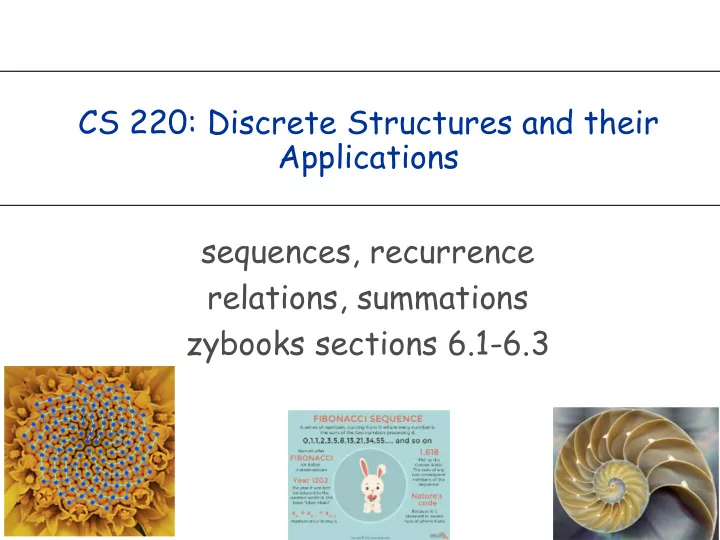

CS 220: Discrete Structures and their Applications sequences, recurrence relations, summations zybooks sections 6.1-6.3
sequences A sequence is a special type of function in which the domain is a consecutive set of integers. Example: Consider a student's GPA in each of their four years in college. Let's express this as a function g : {1,2,3,4} → R , e.g. g(1)=3.67, g(2)=2.88, g(3)=3.25, g(4)=3.75 As a shorthand we'll use subscripts for the domain: g 1 =3.67, g 2 =2.88, g 3 =3.25, g 4 =3.75 When the indices are known you can simply list the sequence of values: 3.67, 2.88, 3.25, 3.75
sequences Sequences can have negative indices, e.g. a − 2 =0, a − 1 =1, a 0 =1, a 1 =0 They can be finite: a m , a m+1 , ... ,a n Or infinite: a m , a m+1 , a m+2 , ... The elements of a sequence can be defined by a formula e.g.: d k = 2 k where k = 0,1,2,... This defines the sequence 1, 2,4,....
geometric sequences A geometric sequence is a sequence of real numbers of the form a, ar,ar 2 ,...,ar n ,... Each element is obtained by multiplying the previous element by the common ratio of the sequence (r); the first number is some arbitrary number (a) Example: 1, 1/2, 1/4, 1/8, 1/16, ... What are a and r for this sequence? A geometric sequence can be finite or infinite.
geometric sequences An individual takes out a $20,000 car loan. The interest rate for the loan is 3%, compounded monthly. Assume a monthly payment of $500. Define a n to be the outstanding debt after n months. Since the interest rate describes the annual interest, the percentage increase each month is actually 3% / 12 = 0.25%. Thus, the multiplicative factor increase each month is 1.0025. The recurrence relation for {a n } is: a 0 = $20,000 a n = (1.0025) ⋅ a n − 1 − 500 for n ≥ 1 The first few values, to the nearest dollar, for the sequence {a n } are: a 0 =$20,000 a 1 =$19,550 a 2 =$19,099 a 3 =$18,647 ⋯
compound interest You deposit $10,000 in a savings account that yields 5% yearly interest. How much money will you have after 30 years? b n = b n − 1 + rb n − 1 = (1 + r ) n b 0 Why?
arithmetic sequences An arithmetic sequence is a sequence of real numbers the form a, a + d, a + 2d, . . . , a + nd, ... Each element is obtained by adding a constant d to the previous element; the first number is some arbitrary number (a) Example: 3, 1, − 1, − 3, − 5, − 7,... a = ? d = ?
recurrence relations A recurrence relation for the sequence {a n } is an equation that expresses a n in terms of one or more of the previous terms of the sequence. Examples: a 0 = a (initial value) a n = d + a n-1 for n ≥ 1 (recurrence relation) a 0 = a (initial value) a n = r ⋅ a n-1 for n ≥ 1 (recurrence relation) write closed forms for a n
recurrence relations A recurrence relation for the sequence {a n } is an equation that expresses a n in terms of one or more of the previous terms of the sequence. Example: the Fibonacci sequence f 0 = 0 f 1 = 1 f n = f n − 1 + f n − 2 for n ≥ 2
recurrence relations A recurrence relation for the sequence {a n } is an equation that expresses a n in terms of one or more of the previous terms of the sequence. Example: the Fibonacci sequence f 0 = 0 f 1 = 1 f n = f n − 1 + f n − 2 for n ≥ 2 ht https://en en.wiki kipedi edia.org/wi /wiki/Fi Fibonacci_number
summation notation Consider a sequence a s , a s +1 , . . . , a t Notation to express the sum of the sequence: upper limit t X a s + a s +1 + . . . + a t = a i i = s lower limit Some useful sums: & = %(%)*) arithmetic series: ∑ "#$ % , & , = %(%)*)(,%)*) sum of squares: ∑ "#$ % - 8 " = 9 :;< =* % ∑ "#$ ./01/2345 6/34/6: 9=*
summation notation Careful: Use of parentheses: t t j 2 + 1 ( j 2 + 1) X X is not the same as j =1 j =1
Recommend
More recommend